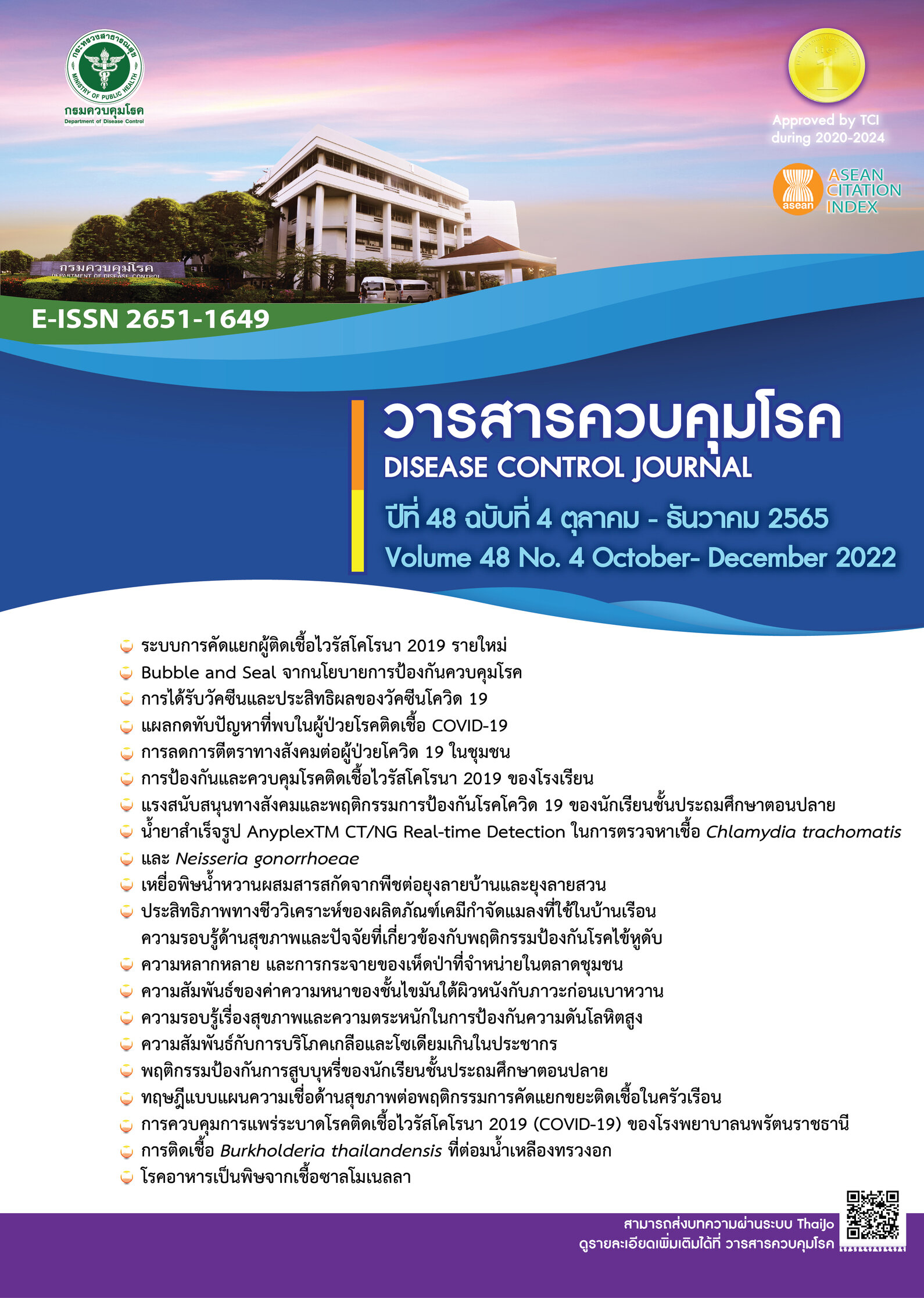Diversity and distribution of wild mushrooms sold in community markets in risk areas of mushroom poisoning outbreak, Health Region 9
DOI:
https://doi.org/10.14456/dcj.2022.71Keywords:
diversity of wild mushrooms, distribution of wild mushrooms, wild mushrooms, community markets, mushroom poisoningAbstract
People consume natural wild mushrooms during the rainy season and harvest them to sell at community markets to generate earnings. Consumption of wild mushroom may contaminate with poisonous mushroom reported as higher incidence rate and deaths of mushroom poisoning. In this study, macroscopic features morphological technique was used to identify 44 wild mushroom samples collected from 8 markets in Chaiyaphum, Buriram and Surin provinces. The result showed that all edible mushrooms can be classified into 6 genera, 6 families, 4 orders and 2 classes in the phylum Basidiomycota. Most of agarics or gilled mushrooms were found (68.18%). Most of them belong to the genera Russula (Hed Khai) at 36.36% and the genera Amanita (Hed Ra-ngok) at 22.73%. A total of 16 mushroom species were found at the Huai Rai community market in Chaiyaphum province. Furthermore, the fruiting bodies of the egg, elongation, and mature stages of the genus Amanita were found in all markets. Patterns of mushroom selling were divided into 3 groups: group 1, 1-type fresh mushroom such as genus Amanita sp., Russula sp., Lentinus sp., Boletus sp., Termitomyces sp. or Astraeus sp.; group 2, mixed fresh mushrooms, particularly a mixture of 2 genera (Russula sp. and Boletus sp.); and group 3, 1-type boiled mushroom such as Astraeus odoratus Phosri, Watling, M.P. Martín & Whalley, Boletus griseipurpureus Corner and Russula delica Fr. In brief, the results from this study indicated that wild mushroom diversity and abundance were still lack of control, particularly mushrooms in different or modified forms such as boiled mushrooms, trimmed mushrooms, tiny egg stage mushrooms, mixed fresh mushrooms and uncompleted parts of mushroom. For this reason, the poisonous mushroom is quite difficult to differentiate from the edible mushroom, because they share similar morphological structures. Above all, community-based poisonous wild mushroom surveillance should be set up and conducted throughout every rainy season to prevent the mushroom poisoning outbreaks in the community.
Downloads
References
O'Brien HE, Parrent JL, Jackson JA, Moncalvo JM, Vilgalys R. Fungal community analysis by large-scale sequencing of environmental samples. Appl Environ Microbiol. 2005;71(9):5544-50.
Chang ST. Overview of mushroom cultivation and utilization foods. In: Cheung PCK editor. Mushrooms as functional foods. Hoboken: John Wiley & Sons; 2008. p.1-33.
Martins A. The numbers behind mushroom biodiversity. In: Ferreira ICFR, Morales P, Barros L, editors. Wild plants, mushrooms and nuts: functional food properties and applications. Hoboken: Wiley-Blackwell; 2017. p.15-63.
Sanoamuang N. Wild mushroom of Thailand: biodiversity and utilization. Bangkok: Universal Graphic and Trading; 2010. (in Thai)
Sangwanit U, Suwanarit P, Payappanon A, Luangsa-ard J, Chandrasrikul A, Sakolrak B. Mushroom biological property inventory. Bangkok: Biodiversity-based economy development office (Public Organization); 2013. (in Thai)
Ruksawong P, Fegel TW. Thai mushrooms and other fungi. Bangkok: National Center for Genetic Engineering and Biotechnology, National Science and Technology Development Agency; 2001. (in Thai)
Vo KT, Montgomery ME, Mitchell ST, Scheerlinck PH, Colby DK, Meier KH, et al. Amanita phalloides mushroom poisonings - northern California, December 2016. MMWR Morb Mortal Wkly Rep. 2017;66(21):549-53.
Jiang L, Luo M, Hao L. Epidemiological characteristics of mushroom poisonings in Yunnan Province, China, 2004–2016. Southeast Asian J Trop Med Public Health. 2018;49(3):509-15.
Kullama P, Sinunta P. Edible wild mushrooms and price value in Nan. Thaksin University Journal. 2011;14(3):65-75. (in Thai)
Chidburee P, Thalawacharat W, Punta L. A survey of edible wild mushroom in Lampang province. Khon Kaen Agriculture Journal. 2014;42(3):825-8. (in Thai)
Tawatsin A, Parnmen S, Thavara U, Siriyasatien P, Kongtip P. Mushroom poisoning in Thailand: Incidence and intoxication to human health. Med Res Arch. 2018:6(9);1-12.
Department of Disease Control (TH), Division of Epidemiology. Epidemiological surveillance dataset records R506: Mushroom poisoning 2015-2019 [Internet]. [cited 2020 Feb 22]. Available from: http://www.boe.moph.go.th/boedb/surdata/disease.php?dcontent=old&ds=58 (in Thai)
Sakolrak B, Duengkae K, Himaman W, Ayawong C, Pongpanich K. Guidelines for mushroom diversity study. Bangkok: Forest and Plant Conservation Research Office, Department of National Park, Wildlife and Plant Conservation; 2017. (in Thai)
Department of Medical Sciences (TH). Guideline for morphology characteristics study, community surveillance and poisonous mushrooms. Nonthaburi: Department of Medical Sciences; 2019.
Das K, Sharma JR, Atri NS. Russula in Himalaya 3: A new species of subgenus Ingratula. Mycotaxon. 2006;95:271-5.
Ndong HE, Degreef J, de Kesel A. Champignons comestibles des forêts denses d'Afrique central taxonomie et identification. Abc Taxa. 2011;10:35.
Sakolrak B, Srisuwun S, Himaman W, Duengkae K, Jangsantear P, Pongpanich K. Utilization of mushrooms around Nam Phong National Park and Phu Wiang National Park, Khon Kaen Province. Proceeding of the 5th national conference on biodiversity management in Thailand; 2018 July 10-14; Diamond Plaza Hotel, Surat Thani. (in Thai)
Kullama P, Sirimat M, Lumyong S. Morphological comparison of Ra-ngok mushroom for classification of non edible type. Proceedings of 49th Kasetsart University annual conference: Science; 2011 February 1-4; The Thailand Research Fund, Bangkok. (in Thai)
Duengkae K. Macrofungi communities in Phukieo-Namnao forest complex. Thai Forest Ecological Research Journal. 2018;2(1):37-44. (in Thai)
Downloads
Published
How to Cite
Issue
Section
License
Copyright (c) 2022 Disease Control Journal

This work is licensed under a Creative Commons Attribution-NonCommercial-NoDerivatives 4.0 International License.
Articles published in the Disease Control Journal are considered as academic work, research or analysis of the personal opinion of the authors, not the opinion of the Thailand Department of Disease Control or editorial team. The authors must be responsible for their articles.






